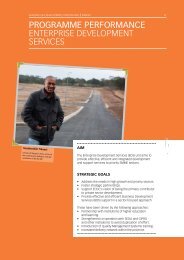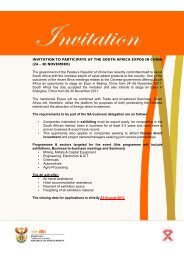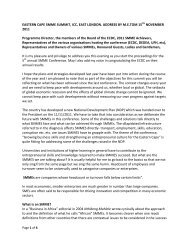2007 / 2008 Annual Report - Eastern Cape Development Corporation
2007 / 2008 Annual Report - Eastern Cape Development Corporation
2007 / 2008 Annual Report - Eastern Cape Development Corporation
- No tags were found...
You also want an ePaper? Increase the reach of your titles
YUMPU automatically turns print PDFs into web optimized ePapers that Google loves.
EASTERN CAPE DEVELOPMENT CORPORATION <strong>2007</strong>/08CONSOLIDATED ANNUAL FINANCIAL STATEMENTSFOR THE YEAR ENDED 31 MARCH <strong>2008</strong>ACCOUNTING POLICIESThe group has created a portfolio provision for incurred but not reported (IBNR) losses. The purpose of the IBNRprovision is to allow for latent losses on a portfolio of loans and advances that have not yet been individuallyevidenced. Generally, a period of time will elapse between the occurrence of an impairment event and objectiveevidence of the impairment becoming evident, which is known as the ‘emergence period’. The IBNR provision is basedon the probability that loans that are ostensibly performing at the calculation date are impaired, and objective evidenceof that impairment becomes evident during the emergence period.The implementation of these principles is at a corporation level and will be specific to the nature of their individual loanportfolios and the loan loss data available to the investment division.Provisions, contingent liabilities and contingent assetsThe group, in the ordinary course of business, enters into transactions that expose the group to tax, legal and businessrisks. Refer to notes 29 and 28 for further information on provisions, contingent liabilities and contingent assets.Fair value of Investment PropertiesFor valuation methodologies utilised to fair value investment properties, refer to note 2.Unlisted investment valuationsThe valuation of unlisted investments is based on the discounted free cash flows of the investments taking into accountthe projected future activities of the entity. These values are established either by independent valuers or managementand are reviewed by the <strong>Development</strong> Investment Committee.1.17 Borrowing costsBorrowing costs that are directly attributable to the acquisition, construction or production of a qualifying asset arecapitalised as part of the cost of that asset until such time as the asset is ready for its intended use. The amount ofborrowing costs eligible for capitalisation is determined as follows:• Actual borrowing costs on funds specifically borrowed for the purpose of obtaining a qualifying asset less anytemporary investment of those borrowings.• Weighted average of the borrowing costs applicable to the entity on funds generally borrowed for the purpose ofobtaining a qualifying asset. The borrowing costs capitalised do not exceed the total borrowing costs incurred.The capitalisation of borrowing costs commences when:• expenditures for the asset have occurred;• borrowing costs have been incurred, and• activities that are necessary to prepare the asset for its intended use or sale are in progress.Capitalisation is suspended during extended periods in which active development is interrupted.Capitalisation ceases when substantially all the activities necessary to prepare the qualifying asset for its intended useor sale are complete.All other borrowing costs are recognised as an expense in the period in which they are incurred.82
















